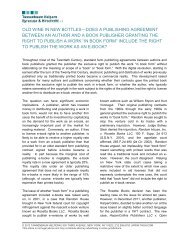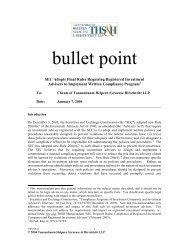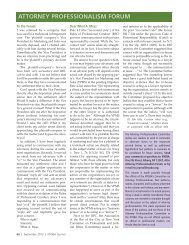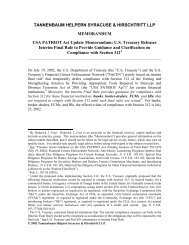Creating Effective Mechanics' Lien Waivers - Tannenbaum Helpern ...
Creating Effective Mechanics' Lien Waivers - Tannenbaum Helpern ...
Creating Effective Mechanics' Lien Waivers - Tannenbaum Helpern ...
- No tags were found...
You also want an ePaper? Increase the reach of your titles
YUMPU automatically turns print PDFs into web optimized ePapers that Google loves.
wednesday, september 14, 2011not limit a contractor’s ability to recover amountsowed through a quantum meruit claim. 4Courts also have recognized that lien waiverspresent a problem for contractors becausethe timing of payment often lags well behindcompletion of work, but payment may not bemade unless the lien waivers are executed. InUnited States ex. rel. F&G Mech. Corp. v. ManshulConst. Corp., 5 the court found that where thecontractor executed a lien waiver acknowledgingthat no other sums were due but that the parties’course of dealing demonstrated that the waiversfunctioned only as receipts for the payments made,the lien waiver did not release claims for otheramounts owed for work the subcontractor hadperformed and was deemed a mere receipt.Crafting <strong>Effective</strong> <strong>Waivers</strong>Owners and general contractors seeking to uselien waivers to limit mechanics’ liens and otherclaims for payment have a fine line to walk. Ifthe lien waiver is too broad, it will run afoul ofSection 34, but if it is too narrow, it will protectthe owner or contractor from mechanic’s liensonly as to the amount stated in the “receipt”lien waiver. Owners and general contractorscan consider using lien waivers which are morecomparable to releases than receipts. Ownersand general contractors should carefully considerthe language in a “release” lien waiver in order toensure themselves the greatest protection frommechanic’s liens while still avoiding vacatur ofthe waiver under Section 34.In order for a lien waiver to function as a releaserather than as a receipt for payment, the waivermust include specific language waiving or releasingclaims and provide the lienor the opportunity topreserve pending and otherwise timely claimswhich may not have yet been the subject of anapplication for payment. The intent to waive aright, such as the right to enforce a mechanics’lien, must be unmistakably manifested on theface of the lien waiver before the waiver can beenforced against the potential lienor. 6To avoid these problems, a lien waiver andrelease should not be limited to a simple recital ofamounts paid and should not contain boilerplatelanguage, such as the party performing the work“represents that it has no claims against [thecontractor or owner] to the date of this requisitionand hereby waives and releases any and all claims,obligations, costs, expenses, causes of action andliens on the premises and/or the improvementthereon.” 7 Courts tend to consider such languageindicative of receipt lien waivers, especially if theparties’ course of dealing provides evidence thatthe parties, too, considered the waivers merereceipts.To function as an effective release, the lienwaiver must contain both unequivocal statementsdemonstrating relinquishment of claims andadditional provisions addressing pendingclaims. Language that a recital of paymentsmade “does not include material furnished, laborperformed, or expense incurred for which writtenauthorization has not been given,” accompaniedby space or schedule to be attached for thepotential lienor to list the additional work ormaterials for which payment had not yet beenrendered, has been found enforceable as a releaseagainst the potential lienor with regard to claimsnot listed. 8This kind of disclaimer, placed above thecertification that the lien waiver is a true statementof account and releases “any claim or claims ofwhatever nature for materials furnished, laborperformed, or expense incurred to date whichis not included in the above amounts or notedin the space above as provided therefore” willmanifest the potential lienor’s unequivocal assentto releasing claims not specified. 9 Additionally,and in order to avoid the revival of stale claims,language should be included in the lien waiverthat notice of the “listed claims” has been timelyprovided in accordance with the terms of thecontract.While not related to the issue of the waiverof claims, the waiver should also contain arepresentation from the contractor that it has paidfor all labor, materials and equipment containedin its current application for payment or will doso upon receipt of the funds covered by the lienwaiver.ConclusionIn order for a lien waiver to function as awaiver of pending claims and not a mere receiptof payment, owners and contractors must draftthe lien waiver carefully by reciting paymentsmade and listing work and materials for whichpayment has not yet been made, and releasingall claims for work and materials other than theitems listed. Such language will demonstrate theintent to release claims and thus be enforced as arelease and not a mere receipt for payment.••••••••••••• • •• •••••••••••••1. 71 A.D.3d 493, 896 N.Y.S.2d 349 (1st Dept. 2010).2. See Tager v. Healy Avenue Realty Corp., 14 A.D.2d 584(2d Dept. 1961) (reducing mechanic’s lien by the amountowed under original contract because contractor had signedenforceable lien waiver for work performed under thatcontract, but foreclosing mechanic’s lien for amounts owedunder supplemental contracts for which no lien waivers wereexecuted).3. See Tager, supra at n.2.4. MCK Bldg. Assocs. Inc. v. St. Lawrence Univ.,301 A.D.2d 726, 754 N.Y.S.2d 397 (3d Dept. 2003).5. No. 94 CV 2436 CLP, 1998 WL 849327 (E.D.N.Y. Oct. 1,1998).6. See Orange Steel Erectors Inc. v. Newburgh Steel Prods. Inc.,225 A.D.2d 1010, 1012 (3d Dept. 1996) (lien waivers manifestedintent to relinquish claims on land and buildings, but did notwaive right to bring an action for additional amounts owed).7. F&G Mech.Corp., 1998 WL 849327, at *8.8. Kay-R Elec. Corp. v. Stone & Webster Const. Co., 23 F.3d 55,57-58 (2d Cir.1994).9. Kay-R Elec., supra at n. 8.Reprinted with permission from the September 14, 2011 edition of the NEW YORK LAWJOURNAL © 2011 ALM Media Properties, LLC. All rights reserved. Further duplicationwithout permission is prohibited. For information, contact 877-257-3382 or reprints@alm.com. # 070-09-11-22






